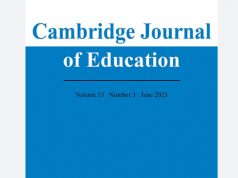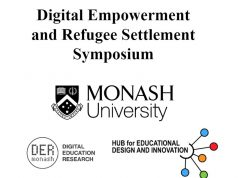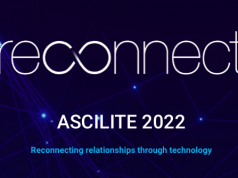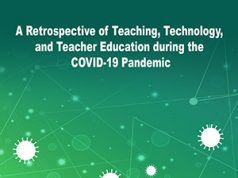
Support for this project has been provided by the Australian Government Office for Learning and Teaching. The views in this project do not necessarily reflect the views of the Australian Government Office for Learning and Teaching.
- Project overview
- About the project
- Project design
- The realities of TEL
- The potential of TEL
- > > Case studies
- > > Conditions for success
- Exploring the challenges
- Publications
- Links
- About the team
This project was led by Monash University in partnership with Griffith University. It was a Strategic Priority Project funded by the Australian Government Office for Learning and Teaching.
Background to the project
This project addresses the long-standing gap between the rhetoric and the realities of TEL. For example, it examines the disparities between the educational potential of technology in comparison to what takes place in practice. This is a tension that recurs throughout much of the research and practitioner literature on technology use within higher education.
On one hand, there is evidence for the potential of digital technology to support and sustain meaningful and effective forms of learning. Networked digital technologies have undoubtedly transformed the generation and communication of knowledge and, it follows, that this has influenced the ways in which learning takes place. The potential to ‘support’, ‘enable’, or even ‘enhance’ learning has therefore been associated with every significant development in digital technology over the past twenty years or so.
Recently, this has involved discussions over the educational benefits of podcasting; blogs and micro-blogs; social networking sites; and other forms of social media. There has been much written about the ways in which digital technology can support creative, connected and collective forms of learning and study. New technologies are widely seen to support students in the co-creation of knowledge with peers, engagement in interest-driven informal learning practices, and the personalised engagement with education on an ‘anytime, anyplace, any pace’ basis.
On the other hand, concerns remain over the less spectacular realities of digital technology use within university teaching and learning. While many commentators talk of collaborative communities of content creators, in reality many students engage with technology in far more passive, sporadic and solitary ways; both for educational and non-educational purposes. For instance, recent studies have found that university students often are ineffective in their use of the Internet and other research tools. As the recent ‘Net Generation’ study of UK universities concluded, students report varying levels of digital confidence and skills often resulting in “surprise or confusion at the array of [educational] technologies that were available.”
Similar shortfalls in engagement have been reported with many of the applications and devices presumed to be integral to the lives of current cohorts of students. As another recent study of university students’ use of social networking sites concluded, educators need to “proceed with caution when using technology-enhanced learning, to avoid over-generalising the needs of the so-called Gen Y students.”
Project Rationale
This project has two aims:
- to find out what uses of digital technology are seen by students and teachers as successfully enabling learning;
- to explore the different factors within the ‘ecology’ of the university that contribute to these successful uses of digital technology.
Of course, these aims relate to a set of complex issues. This project therefore takes a ‘realistic’ perspective on technology-enabled learning (TEL). It recognises that technology use is shaped by all aspects of higher education – ranging from the everyday lives of students’ through to institutional policies and infrastructure.
This final report offers a view of university technology use that is ‘state of the actual’ rather than ‘state of the art’. These are not accounts of the most cutting edge aspects of educational technology. Instead, these are explorations of the everyday uses of digital technology that are actually taking place ‘on the ground’.
The project provides a useful counterpoint to other OLT work that is concerned with exploring the promise of technology. This is an investigation of digital technology and higher education in practice.
Project challenges
Given these considerations, the present project was designed to contribute to the evidence base on how technologies are actually being used successfully and effectively in universities. Specifically, this project was tasked with addressing the question ‘What Works and Why?’ Therefore, the project therefore focused on the following key issues:
| ISSUE #1 | What is the current impact of digital technology on the student experience and student learning outcomes? What technology-based learning opportunities are being made available to students within higher education contexts, and how are they being taken up? What are the key drivers for students within the university ‘ecology’ to adopt different types of learning? What forms of learning are these technologies enabling and with what outcomes? |
| ISSUE #2 | Why are some forms of technology enabled learning successful? What current forms of technology enabled learning are distinct in terms of their variety of outcomes and ‘value-added’? What are the characteristics and contexts of successful technology enhanced learning? Why do these innovations ‘work’ from a wider social and institutional perspective? |
| ISSUE #3 | How can student learning outcomes be technologically-enhanced on a widespread and sustained basis in the near future? How can the circumstances of successful technology enhanced learning be replicated and sustained across and within Australian universities? What longer-term strategic change in higher education institutions is required? |
Project approach
The project was conducted from January 2014 through until April 2015 and was designed as an iterative mixed method investigation conducted over three phases as shown in Figure 1; namely Phase One – focusing on how technology enabled learning was taking place in two large universities; Phase Two – identifying examples of ‘promising practice’ within the two universities; and Phase Three – then exploring how these uses might be sustained across 39 Australian universities in the Australian higher education sector.

Phase One – Mapping the realities of technology-enabled learning
In Phase One, large scale online surveys were administered to students and staff in both Griffith University and Monash University. The surveys were designed to elicit details about what digital technologies students used in relation to their studies, and their experiences of TEL. The survey respondents comprised:
- 1658 undergraduate students;
- 253 masters and postgraduate diploma/ certificate students;
- 507 academic staff (involved in teaching); and
- 301 professional staff (involved in supporting teaching or learning)
Follow-up group interviews were subsequently carried out with students and staff who responded to the surveys. The group interviewees comprised:
- five follow-up group interviews with 35 students; and
- two follow-up group interviews with 13 staff
Phase Two – Exploring the potential of technology-enabled learning
In Phase Two, the project then explored different examples across the two universities where students and teachers identified successful instances of technology-enabled learning. From the findings arising from Phase One of the project, ten diverse examples of ‘promising practice’ were identified across the two universities, and examined in detail as stand-alone case studies.
Each case study of ‘promising practice’ was drawn from:
- technical examination: of the pedagogic/ instructional design elements of these technologies/ technology-based practices;
- interviews with 45 students: relating to the impact of the technology on their learning outcomes and learning experiences;
- in-depth interviews with 12 educators / instructional designers relating to the course design and implementation; and
- observation (in-person and online) of the technology enhanced learning in practice
The purpose of the case studies was two-fold:
- to provide a record of ‘promising practice’ that other educators and institutions may choose to adopt. With this in mind each of the full case study reports includes a brief literature review as well as guidance in terms of implementation and challenges; and
- to provide a rich source of data for analysis, in conjunction with Phase One data, to develop a series of propositions regarding the ‘ecology’ of the TEL, which we have termed ‘conditions for success’
Phase Three – Exploring how to achieve technology-enabled learning across Australian higher education institutions
Finally the project considered ways that current ‘promising practice’ examples of technology enabled learning might be leveraged on a widespread and sustained basis across Australian universities. This involved two activities:
- Expert-group consultations were held within each of the case study universities, whereby 14 teaching and learning university leaders were presented with each of the ten ‘promising practice’ examples, and asked to critically engage with the proposed ‘conditions for success’ required for this technology use to be adopted on a more widespread basis in their institution. This process resulted in a refinement of the phrasing of the ‘conditions for success’ and informed the design of the survey in the next step; and
- A ‘feed-forward’ consultation exercise was then conducted across the 39 universities in Australia. Teaching and learning experts and leaders in each university were contacted and informed of the ‘promising practice’ case studies, and asked to complete brief responses to the ‘conditions for success’ required for the types of technology-enabled learning identified in this project being adopted on a wide-scale basis. This process was highly successful with responses from 85 senior leaders from all 39 universities, along with 29 other leaders. This process then led to a further refinement of the conditions for success, and the development of conclusions for ‘moving forward’
Participation
Over the course of the project, 2952 staff and students were asked to reflect on when and why TEL is successful. This does not include the number of people involved in webinars, seminars, conference presentations or those who may have read the journal articles or media stories.
The realities of TEL
How students use digital technologies
In Phase 1 of the project undergraduate and postgraduate students were surveyed with about the types of digital devices they use in their everyday lives, with these devices often – but not always – supporting their university studies.
The most commonly used devices for university work were:
- Personally owned desktop/laptop (used by 94 per cent of students as part of their university studies);
- Smartphones (used by 71 per cent of students to support their university studies); and
- Tablets/iPads (used by 53 per cent of students with just under three-quarters of these being used for university work)
Amidst the growing trend of ‘bringing your own device’, it was found that:
- Shared computers provided by the universities were regularly used by over 60 per cent of students
In terms of what these digital devices were being used for, the distinction emerged between:
- ‘official’ digital resources and practices (i.e. those provided and/or mandated by universities); and
- ‘non-official’ digital resources and practice (i.e. resources that are not part of university-provided systems and services).
In terms of ‘official’ digital resources, the survey revealed predominance of learning management systems (LMS) and online library resources. Use of all the ‘official’ resources reported in the survey was remarkably consistent across the sample, regardless of subject discipline, level of study or other individual characteristics.
What students find useful
The technology reported by most students as ‘very useful’ was the use of: general Internet search engines (i.e. Google) to find information; this was followed closely by the use of university library online resources to find information and the use of their institutional LMS.
Also rated highly was the use of:
- Academic search services such as Google Scholar and Web of Science;
- YouTube (content sharing websites) for viewing subject-related videos; and
- Other university library resources
Why technologies ‘work’ – student perspectives
Students nominated and justified the digital technologies that they found to be ‘most useful’ during their university studies. Over 4500 examples were nominated, providing rich insights into what students were using digital technologies for, and what meanings were being attached to these practices.
The most prominent ways in which digital technologies were perceived as ‘working’ for students related to the logistics of university study. These practices and activities included:
- Organising schedules and fulfilling course requirements;
- Time management and time-saving; and
- Being able to engage with university studies on a ‘remote’ and/or mobile basis
One of the most prominent learning-related practices directly to learning was using digital technologies to ‘research information’; ‘Reviewing, replaying and revising’ digital learning content (most notably accessing lecture materials and recordings) was also reported at relatively high levels.
Why technologies ‘work’ – staff perspectives
Most frequently nominated ways in which staff perceived digital technologies were ‘working’ related to the logistics of university teaching and learning. These included being able to co-ordinate students, resources and interactions in one centralised place. This reveals a frequently encountered ‘reality’ of digital technologies in this project: technologies are currently perceived by staff and students to have a large, if not primary role to enable the act of being a teacher or student, rather than enabling the learning.
Nevertheless, the staff survey did demonstrate that technologies were valued as a way to provide support learning, including delivering instructional content and information to students in accessible and differentiated forms. This was seen to support ‘visual’ learning, and benefit students who wanted to access content at different times and/or different places.
The potential of TEL – ten case studies of ‘promising practice’
Case studies of ‘promising practice’
Each case study of ‘promising practice’ included three main sections:
- What worked: including a description of the ‘successful’ TEL including how the staff and/or students came to engage with those technologies and practices;
- Why it worked: including a description of the enablers, challenges and reference to what the research literature says about the key practices involved; and
- Moving Forwards: including participant advice, implications for institutions, and additional resources for exploring including guides, cases and readings
The ten cases can be found under the ‘Case studies’ tab, with pdf downloads to each case study.
Conditions for success
A number of over-arching issues can be identified throughout these different instances of promising practice. These can be described as ‘conditions for success’ that appeared to stimulate, support, and/or sustain these specific success stories. These conditions relate to different aspects of the ‘ecology’ of higher education – from individual skills and attitudes through to institutional policymaking.
A detailed description of the Conditions for success can be found under the ‘Conditions for success’ tab.
Case studies
Not all of these are ‘cutting edge’ or ‘text book’ examples of how digital technologies could be used. Nevertheless, these are all instances of where digital technologies were clearly leading to learning gains and improved outcomes. These are instances of digital technology that were valued by students and staff. In short, these are instances of technology-enabled-learning that were ‘working’ in practice.
|
1. |
Immediate feedback in classes: live polling for motivation and learning |
The use of live polls in lectures enabled immediate feedback from students on their understanding of a topic or other points of interest with the explicit goal of helping the lecturers to better shape their teaching during class to meet student learning needs. In addition to promoting engagement of students in a lecture, it also promoted discussion by the students. The practice also served a valuable function of pausing the flow of lecture content, particularly ‘teacher talk’ to allow space for student reflection and encouraged an action based on the reflection (i.e. voting).
|
|
2. |
Illustrating the problem: digital annotation tools in large classes |
The use of digital annotation tools (also known as inking tools) by lecturers to build visual explanations in class to promote an increased level of class interactivity. The activity was not simply to draw, but rather to explain an idea while prompting or eliciting student interaction. This required the lecturer to not only model discipline specific thinking and problem solving but also to adapt the lecture, including the content, according to student interaction. Student’s valued being able to ‘see’ the problem or concept being built.
|
|
3. |
Orchestrating teaching: the implications of flipped classroom |
The use of a flipped classroom approach to allow greater freedom in the delivery design of lectures. This involved teaching theoretical concepts via online videos and then using the face-to-face classes for increased student-teacher interaction. This required considerable orchestration of the technologies, content, delivery as well as the interaction with students. A consequence of an ‘active learning’ approach to lectures was that they were largely ‘unscripted’ in nature. The lectures therefore were more relevant and responsive to students’ needs while also demanding greater active participation.
|
|
4. |
Supporting community and learner preparedness through online forums |
First year arts students in large classes with diverse enrolments have reported feeling a sense of disassociation from their peers. In this case study, online forums were used to address this issue by enhancing student learning by structuring student preparation for classes. This included preparation of the required knowledge, as well as being better prepared to interact with classmates. The online forums generated a sense of community that influenced student engagement both online and in class.
|
|
5. |
Enriching the curriculum with supplementary media |
Enhancing student learning through the use of supplementary videos to demonstrate or illustrate concepts or ideas. This was highly valued by students as a way to ‘rewind, replay and review’ information as often as required. It was felt to support visual learning preferences. It was valued Download full case study report (.pdf)by staff as a way to alleviate pressure for 1:1 learning support by providing supplementary video and other media to cover common concerns, skills and knowledge.
|
|
6. |
Enhancing student learning through rapid prototyping and testing: 3D printing technologies across disciplines |
The use of 3D printing technologies to support student learning in design processes and products. The ability to design and create prototypes in relatively rapid iterations increased conceptual understanding as students could see the problems in their designs. In addition, it sustained student motivation and enabled them to experiment with their thinking, producing highly innovative products. This case was also distinguished by a multidisciplinary approach with students coming together across disciplines, thereby facilitDownload full case study report (.pdf)ating the pollination of new ideas across traditionally siloed domains.
|
|
7. |
Authentic learning experiences through technology-enabled simulations |
The use of technology-enabled simulations to enhance practice-based teaching and learning. Students participate in computer enhanced simulation activities such as clinical role plays that are video recorded and involve computer-controlled mannequins or diagnostic equipment. The conditions are felt to be authentic, with students from different disciplines participating (e.g., nursing, medicine, and pharmacy) in the same simulations to represent the multidisciplinary nature of work, and solving complex problems. The combined use of computer-controlled high-fidelity simulation mannequins, digital video recorded observations and the adaptive release of information in the LMS provide carefully structured and ongoing experiences and feedback.
|
|
8. |
Enabling flexibility where and when learning occurs: learners becoming mobile |
The flexibility of where and when learning takes place was enhanced by providing agency to the learner through an emphasis on the learner being mobile. Through the use of personal digital devices, lecturers and students designed and enacted learning activities which were multimodal through visual, sound and touch screen attributes.
|
|
9. |
Enhancing courses: online technologies for managing, collaborating, reviewing and assessing student learning |
The redesign of face to face courses through online enhancements has resulted in improved learning experiences (reflected in student feedback), and outcomes (reflected in their results). In particular, this redesign has resulted in online learning tools being used for managing, collaborating, reviewing and assessing student learning. There is improved flexibility to support student learning through accessing resources, collaborating with other students and teaching staff. |
|
10. |
Connecting, communicating and learning through social networking sites |
Students are self-organising the use of Facebook and other social networking sites to enhance their learning and to connect with other students in their courses and across cohorts. These sites enable students to ‘friend’ other students; join groups; communicate with individuals or whole groups; and share resources including with peers beyond their university. They use the media to pose questions, comment and coordinate activity outside of the lecturer’s view.
|
Conditions for success
A number of over-arching issues can be identified throughout these different instances of promising practice. These can be described as ‘conditions for success’ that appeared to stimulate, support, and/or sustain these specific success stories. These conditions relate to different aspects of the ‘ecology’ of higher education – from individual skills and attitudes through to institutional policymaking.
In this project the success of TEL was largely dependent on a series of conditions or factors relating to all three actors: institutions, educators & learners.
Technology Enabled Learning: Conditions for success
Importantly, TEL is a broad term and cannot usefully be understood as a single practice, process or outcome. Therefore the ‘conditions for success’ revealed by this project are not necessarily applicable to all instances of TEL, nor are they an exhaustive list. However, they do describe a series of significant contributing factors to the ‘success’ of TEL. Conceptually, they have been organised according to those conditions attributable to institutions, educators and the learners themselves.
For an explanation of the 13 conditions for success please access the full report here:
Exploring how to achieve TEL across Australian higher education
In Phase Three of the project, the feasibility of these ‘conditions for success’ on a widespread basis across Australian universities was explored. Expert-group consultations were conducted with teaching and learning experts and leaders in both universities. These consultations informed the refinement of the ‘conditions for success’ and provided useful ideas for how they could be addressed by institutions which in turn influenced the design of the nationwide survey.
A survey was distributed to leaders across all Australian universities. ‘The conditions for success’ were pitched in a form that could be operationalized by university leaders.
Respondents were asked to comment on:
- how essential each of these conditions was to achieving successful TEL;
- how close their institution was to achieving these conditions; and
- barriers and problems to achieving these conditions from an institutional perspective.
A total of 114 survey responses were received from university leaders and managers, including 85 senior leaders (ranging from Pro-Vice Chancellors through to Faculty Deans) across all 39 universities in Australia.
The responses offered both a useful rejoinder to our previous discussions of ‘promising practices’, and a useful understanding of the ‘state of play’ across the sector in terms of priorities and perceived barriers.
International peer-reviewed journal articles
In addition to these deliverables, the project team continues to produce a number of research articles based on the different stages of the project. The following articles have already been accepted and are in press:
Henderson, M., Selwyn, N. & Aston, R. (2017). What works and why? Student perceptions of ‘useful’ digital technology in university teaching and learning. Studies in Higher Education, 42(8), 1567-1579. http://dx.doi.org/10.1080/03075079.2015.1007946
Henderson, M., Finger, G. & Selwyn, N. (2016). What’s used and what’s useful? Exploring digital technology use(s) amongst taught postgraduate students. Active Learning in Higher Education, 17(3), 235-247. http://dx.doi.org/10.1177/1469787416654798.
Selwyn, N. (2016). Digital downsides: Exploring university students’ negative engagements with digital technology. Teaching in Higher Education, 21(8), 1006-1021. https://doi.org/10.1080/13562517.2016.1213229
Selwyn, N., & Gorard, S. (2016). Students’ use of Wikipedia as an academic resource: Patterns of use and perceptions of usefulness. The Internet and Higher Education, 28, 28-34. https://doi.org/10.1016/j.iheduc.2015.08.004
Henderson, M., Selwyn, N., Finger, G., & Aston, R. (2015). Students’ everyday engagement with digital technology in university: exploring patterns of use and ‘usefulness’. Journal of Higher Education Policy and Management, 37(3), 308-319. http://dx.doi.org/10.1080/1360080X.2015.1034424
Reports
Seminars and conference presentations
Emerging project findings have been disseminated through a number of local, national and international conferences and seminars – in particular:
Henderson, M. (2015, March). Conditions for success: technology enhanced learning. Paper presented at Innovations in Teaching and Learning seminar series, The Centre for the Study of Higher Education, Melbourne University. https://vimeo.com/124486784
Finger, G. (2014, December). What works and why: Understanding successful technology enabled learning in Australian higher education. Paper presented at BETT Asia Leadership Summit, Singapore.
Smart, V. (2014, November). What works and why: Understanding successful technology enabled learning within institutional contexts. Paper presented at the Ascilite conference, Dunedin, New Zealand.
Henderson, M., Selwyn, N. & Finger, G. (2014, September). Mapping the realities of technology-enabled learning in universities. Paper presented at British Educational Research Association Annual conference, London.
Henderson, M., Selwyn, N. & Finger, G. (23rd April 2015). OLT Strategic Commissioned Project: What works and why?
This is a recording of a webinar hosted on the reporting on some of the key findings from the project.
Media coverage
These activities resulted in a range of international press coverage in Australia, UK and India. A full range of media releases will accompany the publication of this end-of-project report:
- The Sydney Morning Herald (2015) ‘Time to ask students about use of digital technologies in lectures’, 21st June
- Times Higher Education (2015) ‘Digital aids: students reveal ‘benefits’ of technology’ 9th April
- The Australian (2015) ‘Twitter the least used resource’ 18th February
- The Hindu (2015) ‘Don’t be ashamed of using Wikipedia!’ 18th February [India]
- Times of India (2015) Need to find better ways to integrate Wikipedia in higher education’ 12th February [India]
- Times Higher Education (2015) ‘Wikipedia should be ‘better integrated’ into teaching’ 11th February
- The Australian (2015) ‘Wikipedia is not destroying education as we know it’ 11th February
In addition to the news media we have had some interest in our work through our social media outlets. For example, the initial release in September 2014 of ‘Headline Findings’ infographic from our student survey was distributed to 940 ‘followers’ via Twitter and retweeted 30 times by followers to their extended networks.
Relevant projects
- Educause – Critical Success Factors of Technological Innovation
- JISC – Visitors and Residents: What Motivates Engagement with the Digital Information Environment?
- SAIDE – Unlocking the potential of ICT in Higher Education
- Student Uses Of Technologies For Learning: An Ethnographic Study
- ECAR – Study of Undergraduate Students and Information Technology
- Open University – The Net Generation Encountering e-learning at University
- JISC – Developing Digital Literacies – Mapping Spaces, Tasks and Tools
- JISC – Digital Literacies as a Postgraduate Attribute
Other OLT projects
- Business Capstones Project
- Capstone Curriculum across Disciplines
- Reforming banking pedagogy with online simulation
- eDST: Decision support tools for multi-disciplinary applications in higher education
- Curate, credential and carry forward digital learning evidence
- Building academic staff capacity for using eSimulations in professional education for experience transfer
- Managing patient deterioration: enhancing nursing students’ competence through web-based simulation and feedback techniques
- Situational eLearning: a crowdsourcing approach to the definition and assessment of key practice-ready academic outcomes
- Business education in the 21st century: Examining the antecedents and consequences of student team virtuality
- Realising the potential: assessing professional learning through the integration of ePortfolios in Australian business education
.
 Michael Henderson is a Senior Lecturer in Information Communication Technologies in Education at Monash University. He has provided expert advice to government and other education providers in the field of eLearning and delivered many keynotes at conferences with the aim of expanding delegates understanding of the opportunities afforded by educational technology, both in online and in-class environments. Michael was the leader of the Monash Centre for Educational Multimedia (CEMM) which has transformed into the Learning with New Media Research Group in which he continues as a key member. The group provides leadership in rigorous empirical research for the advancement of our understanding of teaching and learning and the various roles of technologies. Michael has been an executive member of AARE and a state councillor of ICTEV and is the co-editor of the Digital Learning and Teaching Victoria Journal. Michael is an associate editor of the Australasian Journal of Educational Technology.
Michael Henderson is a Senior Lecturer in Information Communication Technologies in Education at Monash University. He has provided expert advice to government and other education providers in the field of eLearning and delivered many keynotes at conferences with the aim of expanding delegates understanding of the opportunities afforded by educational technology, both in online and in-class environments. Michael was the leader of the Monash Centre for Educational Multimedia (CEMM) which has transformed into the Learning with New Media Research Group in which he continues as a key member. The group provides leadership in rigorous empirical research for the advancement of our understanding of teaching and learning and the various roles of technologies. Michael has been an executive member of AARE and a state councillor of ICTEV and is the co-editor of the Digital Learning and Teaching Victoria Journal. Michael is an associate editor of the Australasian Journal of Educational Technology.
 Neil Selwyn is a Professor in the Faculty of Education, Monash University. He has worked previously at the Institute of Education – University of London, Cardiff University and the University of Bristol (all UK). Neil’s research and teaching focuses on the place of digital media in everyday life, and the sociology of technology (non)use in educational settings. Neil has written extensively on a number of issues, including digital exclusion, education technology policymaking and the student experience of technology-based learning. He has carried out funded research on digital technology, society and education for the Australian Research Council (ARC), Economic and Social Research Council (ESRC), British Academy, the BBC, Nuffield Foundation, the Gates Foundation, the Spencer Foundation, Microsoft Partners in Learning, Becta, Centre for Distance Education, the Welsh Office, National Assembly of Wales and various local authorities.
Neil Selwyn is a Professor in the Faculty of Education, Monash University. He has worked previously at the Institute of Education – University of London, Cardiff University and the University of Bristol (all UK). Neil’s research and teaching focuses on the place of digital media in everyday life, and the sociology of technology (non)use in educational settings. Neil has written extensively on a number of issues, including digital exclusion, education technology policymaking and the student experience of technology-based learning. He has carried out funded research on digital technology, society and education for the Australian Research Council (ARC), Economic and Social Research Council (ESRC), British Academy, the BBC, Nuffield Foundation, the Gates Foundation, the Spencer Foundation, Microsoft Partners in Learning, Becta, Centre for Distance Education, the Welsh Office, National Assembly of Wales and various local authorities.
 Glenn Finger is the Dean (Learning and Teaching) of the Arts, Education and Law Group and provides leadership in learning and teaching, and develops strategies to implement Group plans and achieve Group targets. In this role, he reports to the Pro Vice Chancellor of the Group and works closely with the Dean (Academic), the Dean (Research) and the following Arts, Education and Law schools to integrate learning, research and staffing strategies in the Group and to develop Group operational plans in the following areas- School of Education and Professional Studies; School of Languages and Linguistics; School of Humanities; Griffith Law School; School of Criminology and Criminal Justice; Queensland College of Art; Queensland Conservatorium. He is Chair of a number of teaching and learning committees and a founding member of the Virtual Faculty of the Griffith Honours College. Throughout his academic career, his teaching and research interests have focused on the use of information and communication technologies to enhance and transform learning and teaching. He has published extensively with more than 100 publications and this research has informed his scholarship of teaching.
Glenn Finger is the Dean (Learning and Teaching) of the Arts, Education and Law Group and provides leadership in learning and teaching, and develops strategies to implement Group plans and achieve Group targets. In this role, he reports to the Pro Vice Chancellor of the Group and works closely with the Dean (Academic), the Dean (Research) and the following Arts, Education and Law schools to integrate learning, research and staffing strategies in the Group and to develop Group operational plans in the following areas- School of Education and Professional Studies; School of Languages and Linguistics; School of Humanities; Griffith Law School; School of Criminology and Criminal Justice; Queensland College of Art; Queensland Conservatorium. He is Chair of a number of teaching and learning committees and a founding member of the Virtual Faculty of the Griffith Honours College. Throughout his academic career, his teaching and research interests have focused on the use of information and communication technologies to enhance and transform learning and teaching. He has published extensively with more than 100 publications and this research has informed his scholarship of teaching.
 Kevin Larkin is Lecturer (Mathematics Education) at Griffith University. He is a member of a number of research teams investigating mathematics education in primary and middle school contexts. He is a member of the Griffith Institute of Educational Research (GIER) and has published widely in national and international publications in the areas of ICT, mathematics education, school leadership, and Activity Theory. He is the current VP Communications for the Mathematics Education Research Group of Australasia (MERGA) and a Board Member of the Queensland Society for Information Technology in Education (QSITE).
Kevin Larkin is Lecturer (Mathematics Education) at Griffith University. He is a member of a number of research teams investigating mathematics education in primary and middle school contexts. He is a member of the Griffith Institute of Educational Research (GIER) and has published widely in national and international publications in the areas of ICT, mathematics education, school leadership, and Activity Theory. He is the current VP Communications for the Mathematics Education Research Group of Australasia (MERGA) and a Board Member of the Queensland Society for Information Technology in Education (QSITE).
 Rachel Aston is project manager for the OLT TEL ‘What works and why’ project. Rachel’s skills and expertise are in the development of grants and project proposals, project planning and management and engaging with stakeholders across different sectors and cultures. Rachel has several years’ experience working in program evaluation and educational research. She has worked on a number of national and international projects, including national and international education reforms and community-based programs to enhance educational engagement for severely disengaged youth. Her work has included collaborating with the state departments of education in Vic DEECD, SA DECD, WA DoE and TAS DoE. She has also worked with the Ministry of Education in Malaysia as well as not-for-profit education organisations in Victoria.
Rachel Aston is project manager for the OLT TEL ‘What works and why’ project. Rachel’s skills and expertise are in the development of grants and project proposals, project planning and management and engaging with stakeholders across different sectors and cultures. Rachel has several years’ experience working in program evaluation and educational research. She has worked on a number of national and international projects, including national and international education reforms and community-based programs to enhance educational engagement for severely disengaged youth. Her work has included collaborating with the state departments of education in Vic DEECD, SA DECD, WA DoE and TAS DoE. She has also worked with the Ministry of Education in Malaysia as well as not-for-profit education organisations in Victoria.
 Vicky Smart is a high school teacher who is in the final stage of completing her PhD at Griffith University where she is looking at how teachers pedagogically reason with technology with an aim of elaborating on Technological Pedagogical Reasoning. She has presented her research at (inter)national conferences in Australia, New Zealand and the USA. She was awarded a Outstanding paper at SITE2013 conference. She has used digital portfolios, video-stimulated recall interviews and think aloud concept mapping as part of research project. She has worked as a research assistant on multiple projects at Griffith University
Vicky Smart is a high school teacher who is in the final stage of completing her PhD at Griffith University where she is looking at how teachers pedagogically reason with technology with an aim of elaborating on Technological Pedagogical Reasoning. She has presented her research at (inter)national conferences in Australia, New Zealand and the USA. She was awarded a Outstanding paper at SITE2013 conference. She has used digital portfolios, video-stimulated recall interviews and think aloud concept mapping as part of research project. She has worked as a research assistant on multiple projects at Griffith University
 Shu-Hua Chao was a primary school teacher who became interested in research. Her expertise lies in the field of ICT in education and female participation in STEM. She has worked and conducted research in both Australia and Taiwan enabling an international, and cross-cultural lens to her work. Shu has taught postgraduate and undergraduate studies in educational technology, instructional design, learning theory, and educational psychology. Shu is also a skilled project manager and research fellow, having worked on funded projects from the Spencer Foundation and the Australian Government Office for Learning and Teaching.
Shu-Hua Chao was a primary school teacher who became interested in research. Her expertise lies in the field of ICT in education and female participation in STEM. She has worked and conducted research in both Australia and Taiwan enabling an international, and cross-cultural lens to her work. Shu has taught postgraduate and undergraduate studies in educational technology, instructional design, learning theory, and educational psychology. Shu is also a skilled project manager and research fellow, having worked on funded projects from the Spencer Foundation and the Australian Government Office for Learning and Teaching.
![]() The above content is licensed under the Creative Commons Attribution-ShareAlike 4.0 International License. Information on the creative commons licence can be found at: http://creativecommons.org/licences and http://creativecommons.org/licenses/by-sa/4.0/
The above content is licensed under the Creative Commons Attribution-ShareAlike 4.0 International License. Information on the creative commons licence can be found at: http://creativecommons.org/licences and http://creativecommons.org/licenses/by-sa/4.0/













